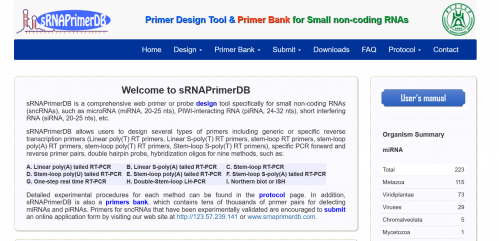
Recently, theThe latest research paper “sRNAPrimerDB: Comprehensive primer design and search web service for small non-coding RNAs” has been published on “Bioinformatics”, an international academic journal of bioinformatics, which is the recent finding of pig breeding and genetics team in College of Animal Sciences & Technology / College of Veterinary Medicine(CAS&T&VM). In this paper, it introduces a new software and database of primers design for small non-coding RNAs (sncRNAs).
Small RNA is a kind of small RNA molecule which can transcribe but not encode protein and has specific regulatory function, such as microRNA (miRNA), PIWI-interacting RNA (piRNA) and short interfering RNA (siRNA). Abnormal expression of small RNA will cause disorder of physiological activities on plants and animals and even diseases. Small RNA is often used as a new biomarker in clinical and animal breeding fields. Due to the short fragments of mature miRNA, there is usually only one or two base differences of the same kind, and precursor molecules may be expressed in cells which adds the inaccuracy to the detection.
At present, the detection methods of small RNA are mainly based on the two strategies, RT-PCR and probe hybridization. The length of mature miRNA, piRNA and siRNA is 18-25 nucleotide(nt), 29-32 nt, and 19-22 nt respectively. So, it is difficult to design primers in terms of similar length between the small RNAs and PCR primers. Primers or probes are also the key to determine the sensitivity and specificity of small RNA expression detection methods. Currently, one major challenge in small RNA research field is how to design high-quality primers for experimental detection.
To solve this problem, the pig breeding and genetics team in HZAU has developed a new software called sRNAPrimerDB for small RNA primers or probes. The software designs the best primer pairs or probes by using a multi-factor primer specificity evaluation system to assess primers and thermodynamic parameters instead of simple sequence alignment to evaluate primer dimers as well as the strict control on primer disassociation temperature. It mainly provides one-stop service for 9 mainstream small RNA expression detection methods including A. Liner poly(A)-tail RT-PCR、, B. Liner S-poly(A)-tail RT-PCR、, C. Stem-loop RT-PCR、, D. Stem-loop poly(U)-tail RT-PCR、, E. Stem-loop poly(A)-tail RT-PCR、, F. Stem-loop S-poly(A)-tail RT-PCR、, G. One-step sRNA RT-PCR、, H. Double-Stem-loop LH-PCR and I. Northern blot or ISH. The methods E and F are new small RNA detection method developed by the team (patent number CN201610785072.0).
The software, featured in quick running and easy operation, reads the small RNA sequence entered by the user, and then program will design reverse transcription primers, PCR primer pairs or probes, according to the user-set small RNA detection method. Besides, the software website also provides up to 531,306, 2,941,669 primers or probe datasets for miRNA and piRNA respectively, for users’ query and downloading. There are also detailed experimental procedures of different small RNA detection methods available for reference on the website. The software developed by the team has obtained two software copyright registration certificates (2015 SR095326 and 2015 SR184550) for now.
It’s reported that sRNA PrimerDB website provides a one-stop service for efficient, accurate, fast and low-cost detection of small RNA expression. The first co-authors of this paper in turn are Xie Shengsong, an associate professor in CAS&T&VM, Zhu Qin, a postgraduate student in College of Information(CI), and Qu Wubin, a researcher of iGene-Tech & Biotechnology (Beijing) Co., Ltd. Professor Zhao Shuhong in CAS&T&VM and associate professor Fang Yapin in CI are both the corresponding authorauthors of this paper. The research has been funded by the cultivation of new varieties of genetically modified organisms project, the national key research and development program on stem cells and transformation project, and the National Natural Science Foundation of China.
Source: http://www.srnaprimerdb.com
Translated by: Liu Shaokang
Supervised by: Wang Xiaoyan